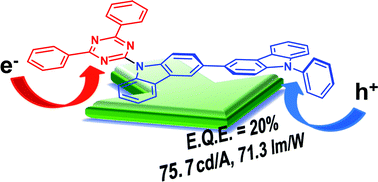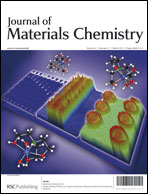A novel bipolar host material 9-(4,6-diphenyl-1,3,5-triazin-2-yl)-9′-phenyl-3,3′-bicarbazole (CzT) comprising a dicarbazole donor linking to an electron deficient 1,3,5-triazine acceptor was synthesized and characterized. The molecular design of CzT allows the spatial separation of HOMO and LUMO on the donor and acceptor moieties, respectively, giving sufficient triplet energy (2.67 eV) together with promising physical properties and morphological stability (Tg = 134 °C). This tailor-made material was used as a host for an efficient yellowish-green iridium complex, bis(o-tolylpyrimidinato-N,C2′)Ir(III)acetylacetonate [(TPm)2Ir(acac)]; the as-fabricated phosphorescent OLEDs (PHOLEDs) demonstrated high performance, with maximum efficiencies of 20.0% (75.7 cd A−1 and 71.3 lm W−1) and 20.1% (76.3 cd A−1 and 72.7 lm W−1) achieved in trilayer and bilayer device architectures, respectively. The efficiency of the trilayer device can sustain ∼20% over a wide brightness range from 102 to 103cd m−2 due to the more effective confinement of emissive excitons within the emitting layer.

You have access to this article
 Please wait while we load your content...
Something went wrong. Try again?
Please wait while we load your content...
Something went wrong. Try again?


 Please wait while we load your content...
Please wait while we load your content...